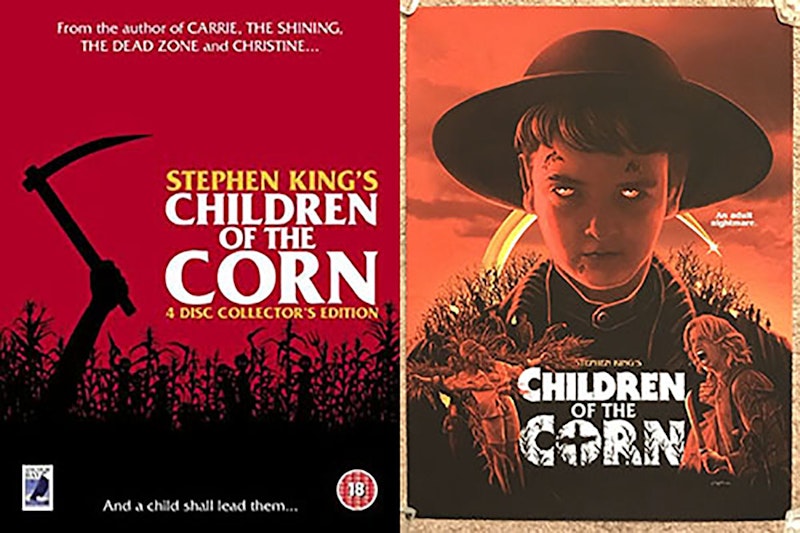Originally, “The Children of the Corn” wasn’t about corrupted children. It was about a corrupted marriage.
A new reboot/remake of the Stephen King story was released this year. Unlike the 1984 adaptation, it presents the adults in the story as weak, misguided, violent, and untrustworthy. But it still spends most of its narrative energy on the rural children in thrall to some demon and their violent attack on their elders. It’s a narrative of generational struggle. The fear is the fear that those disobedient kids will rise up and destroy everything adults hold dear.
King’s original story, first published in his 1978 Night Shift collection, has a different emphasis. Like The Shining, released the previous year, the story’s centered on the perspective and experience of an angry, possibly violent man—in this case, Vietnam veteran Burt. Burt and his wife Vicky are driving across the country to see Vicky’s brother. They hope the trip will save their fracturing marriage.
It doesn’t. Instead, the stress exacerbates their mutual loathing. Somewhere near nowhere Gatlin, Nebraska, Vicky’s nagging enrages Burt to the point that he has to clutch the steering wheel with white knuckles lest “one of those hands might just fly off and hit the ex-Prom Queen beside him right in the chops.” He takes his eyes off the road to tell Vicky he’s ready for a divorce immediately—and that’s when they run over a child who’s dashed into the road.
Those familiar with the 1984 film will know what happens next. The child they killed already had his throat slit for betraying his community—a community composed children who worship a corn demon. The children of the corn murdered all their parents. They now control the town, sacrificing their own members when they turn 20, and other passersby when they have the chance.
The plot may be more-or-less intact, but the details aren’t. In the original movie, you spend much of the runtime with a pair of adorable young children who live with the children of the corn but don’t worship the demon. The adult couple on screen has some arguments, but they don’t hate each other. Adversity strengthens them, and they battle the evil together.
Not in King’s version. When Burt and Vicky run over the child, that’s the end of their relationship. He’s an unwieldy, bloody symbol of their marriage’s failure. It’s like they’ve run over their own future child.
And things only get worse from there. For the bulk of the rest of the 40-page story, the two fight. Burt wants to find authorities to report the death; Vicky wants to leave the abandoned town of Gatlin as quickly as possible. When Burt decides to explore the creepy church, Vicky threatens to drive away without him. At that point Burt grabs her purse and steals her keys. She’s helpless when the children come for the car and drag her off to the cornfield, strapping her to a cross with barbed wire. When Burt finds her sometime later, “Her eyes had been ripped out. The sockets were filled with the moonflax of cornsilk. Her jaws were wrenched open in a silent scream, her mouth filled with cornhusks.”
Instead of being part of a fertile marriage, Vicky is a fertility sacrifice—the sterile relationship flowers into a grotesque crop of rage and death. Burt doesn’t last much longer; he’s soon eaten by whatever it is out there in the corn. After he’s gone, King waits for a beat and then informs us, “Some time later, a bloated orange harvest moon came up.”
King’s story has more of a sickly charge than its adaptations in part because the author’s willing to give the narrative an unhappy ending; the demon wins. The final line of the story is, “Around Gatlin the corn rustled and whispered secretly. It was well pleased."
The real difference, though, between the original and the pretenders is not that evil is victorious, but that there isn’t really any good to root for. Burt’s thoroughly unlikable, mired in self-pity and misogyny. Again, he recalls Jack in The Shining, whose alcoholism mirrored King’s own, and who hates his wife in no small part because she reminds him of how he’s failing her and failing himself. Vicky, who spends most of the novel in a fit of fear and rage, isn’t much of a point of identification either.
The children wield the scythe. But they’re only imitating the adults, who are determined to tear each other apart. Hollywood always wants to give its audience someone to root for. But the original “Children of the Corn” works because it’s so suffused with hate and disgust at human beings, human faith, human reproductive rituals, and humanity’s repulsive fecundity. King’s there beside the demon, licking his lips and watching the bloated moon come up. Hollywood, after more than 40 years of adaptations, isn’t ever going to want to join him there behind the rows.

